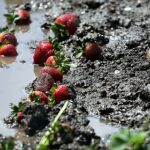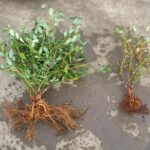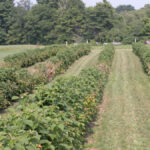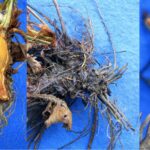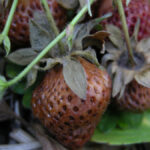As we wait for the locusts (actually, seventeen-year cicadas), and deal with a plague of biblical proportion, many across the state also experienced flooding and frosts. Indiana weather is never dull! Flooding and/or frosts during periods of active growth can significantly damage flower and fruit, resulting in crop loss (Fig. 1). Unfortunately, many berry growers had actively growing plants whose roots were under water for > 48 hours due to flooding, on top of cold conditions and frost.
When soils are flooded, soil pore space fills with water, displacing the air and depriving roots of oxygen needed for water uptake and photosynthesis. Not only can plants not photosynthesize, but their roots leak, losing nutrients, and begin dying. The first plant symptoms of flood damage are wilted leaves that may develop a yellowish cast or off-green color, a result of apoxia (not enough oxygen), along with symptoms of nutrient deficiencies (nitrogen and potassium). Other symptoms of waterlogging and flood damage include flower or fruit drop, along with leaf curl (epinasty) or drop (abscission), or symptoms of nutrient deficiency. The lack of oxygen results in the closing of stomates (gas exchange pores on leaves), followed by a stoppage of photosynthesis. If the situation remains anaerobic, an odor of rot may develop, as roots turn brown and die. Leaf wilt and curl often happen after the flood, when fields dry out, new roots haven’t grown, and damaged roots are unable to take up sufficient water to support the plant.
If flooding was brief and plants were only stressed, watch crop development to determine if side dressing or foliar application of nitrogen or potassium are needed. When applying nitrogen, nitrate-based fertilizers provide more balanced growth than ammonium-based fertilizers. Potassium nitrate addresses the loss of both key nutrients due to leaching.
If all of this wasn’t bad enough, these same wet conditions favor disease outbreaks, as leaking and dying roots attract the zoospores of Phytophthora and Pythium, that swim towards these roots and infect the plant. After flooding, check all berry crops (except grape, which is rarely infected) for Phytophthora root rot symptoms. Blueberry plants infected with by Phytophthora may be stunted, or develop scorched, yellow leaves that may defoliate (Fig. 2). Brambles are highly susceptible as well (Fig. 3), especially red raspberry varieties Canby, Hilton, Ruby, Polana, and Titan. Black raspberry cultivars, such as Bristol, Dundee, and Jewel are considered moderately to highly resistant to root rot and blackberry cultivars are also relatively resistant to Phytophthora.
On strawberry, red stele is a common name for the root and crown rot that develops (Fig.4). Symptoms include wilted foliage during hot weather and stunted foliage. A key diagnostic symptom is the red stele (core of the strawberry root-crown) that appears when roots are cut longitudinally (Fig. 4). Red stele reduces yield, fruit size and quality. Resistant strawberry cultivars include such as Earliglow, Allstar, Guardian, LateglowMidway, Redchief, Redglow, Sparkle, Sunrise, and Surecrop; Honeoye, Jewel, and Cardinal are very susceptible. This list can be found in the Midwest Fruit Pest Management Guide at https://ag.purdue.edu/hla/Hort/Documents/ID-465.pdf
Leather rot is another disease caused by a different Phytophthora species infects strawberry fruit (Fig. 5) or the plant crown. Infection occurs during flowering or after fruit set when conditions are wet and when berries contact the soil. Infected blossom clusters turn brown and die; on immature fruit, infected areas appear brown to black. As fruit matures and ripens, the color ranges from light tan (bleached) to light red or green fruit become hard and leathery. The flavor of the infected fruit is somewhat appalling, bitter and the texture is tough.
Even plants that survive flooding are often stressed, weakened and more susceptible to plant pathogens, especially to anthracnose and botrytis to the above-ground portions (More on that next time).
Going forward, if flooding was severe, and crops were lost, consider the possible a short-term cover crop like buckwheat or rye, which can be planted and mowed in time for fall planting. Deep rooted cover crops (forage radish and turnip, sudangrass, sorghum) may also improve soil compaction and drainage.
Fungicides recommendations vary per crop, and are listed in detail in the Midwest Fruit Pest Management Guide.
For more information see: https://blogs.cornell.edu/livegpath/gallery/strawberries/red-stele-root-rot-of-strawberry/ and http://www.omafra.gov.on.ca/IPM/english/strawberries/diseases-and-disorders/leather-rot.html#beginner
- Figure 1. Spring flooding is a recurring problem in the Midwest. Photo by Dan Coyro, AP.
- Figure 2. Phytophthora root rot on blueberry. Photo by Jerry Weiland, USDA.
- Figure 3. Raspberry production impacted by Phytophthora outbreak. Photo by OMAFRA.
- Figure 4. Red stele. Photos by Meg McGrath, Cornell.
- Figure 5. Leather rot. Photo by OMAFRA.
